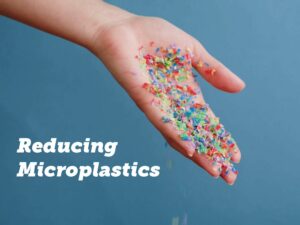Reducing Microplastics Without Losing Your Mind!
Last week we discussed some things you need to know about microplastics.
These tiny plastic particles are everywhere, including the air we breathe, the water we drink, the clothes we wear, and many of the things we touch. We ingest them every day, and it’s impossible to avoid them.
There is a growing amount of research suggesting microplastics are linked to heart disease, brain disease, and reproductive issues.
We live in a world where it’s impossible to avoid plastics. And trying to do so could drive you crazy. The good news: you can do some simple things to greatly reduce the number of plastics you and your family encounter on a regular basis.
1. Avoid all drinks that are bottled in plastic.
People who consume all their water from bottled water sources may be ingesting an additional 90,000 microplastic particles annually, compared to 4000 microplastics for people who consume only tap water.

Another study found that a standard liter water bottle contains about 125,000 particles of nanoplastics (microplastics that are 1000 nanometers in size).
It’s okay to drink a bottle of water or a sports drink occasionally when that’s the only thing available. But drinking from bottles all day long will increase your microplastic intake more than anything else you do.
2. Drinks in cans and glass bottles aren’t much better.
A study published in June looked at the differences in microplastics in beverages packaged in plastic bottles, glass bottles, and cans. The study found no difference in the amount of microplastics in the three different types of beverage containers.
But shouldn’t aluminum and glass be better choices for avoiding microplastics? Turns out manufacturers use plastics in both container types.
Aluminum cans have an internal plastic coating that provides a “protective” barrier between the beverage and the metal.
A lot of glass bottles are made through a recycling process that includes small amounts of plastic. And the padding within the caps of glass bottles is made of plastic.
3. Use a steel or glass reusable water bottle
Plastic water bottles degrade through heat, washings, and abrasions, which can leach microplastics into your water. Most plastic water bottle manufacturers have switched to BPA-free plastics.
BPA stands for bisphenol A, which is an industrial chemical that has been used to make polycarbonate plastics since the 1950s. Plastics containing BPA seem to produce the most offensive microplastics because of their effects on the brain and prostate glands of fetuses, infants, and children.
The BPA-free plastics that most water bottle manufacturers are using still produce microplastics. Spend the money on a nice steel or glass water bottle. My favorite is Klean Kanteen with a bamboo lid.
4. Filter Your Tap Water
Tap water contains varying levels of microplastics depending on where you live. But tap water contains far fewer elements than bottled water. One of the best ways to remove microplastics from your tap water is install a reverse osmosis system.
A study published in 2023 found that reverse osmosis can remove up to 95% of microplastics from tap water.
5. Upgrade your coffee and tea.
Hot water accelerates the formation of microplastics because heat degrades plastics. If you make your morning coffee in a plastic coffee maker, you are increasing your microplastics exposure quite a bit.
Most drip coffee makers run hot water through a bunch of plastic components. A Keurig blasts hot water through a punctured plastic K-cup. And most paper coffee filters contain plastic chemicals to keep them from falling apart.
Tea also poses a problem because teabags contain nylon, polypropylene, and polyethylene. One study found that brewing a single teabag can release as many as 11.6 billion microplastics and 3.1 billion nanoplastics in a single cup of tea.
The solution for fewer plastics in your coffee or tea is a French press or a pour-over coffee maker. You bypass the plastics when you use loose-leaf tea or fresh ground coffee beans. I’ve used a Chemex pour-over coffeemaker for years. Their filters are 100% paper made from American products.
Making coffee with a French press or pour-over coffee maker provides another benefit. Boiling tap water to make the drink significantly reduces the amount of plastics in the water. One study found that boiling tap water can remove 80% of the polystyrene, polyethylene, and polypropylene (microplastics).
 6. Filter your air
6. Filter your air
Filtering microplastics in your air is second to—if not as important as—filtering your water. Your home is full of plastic products that are constantly degrading and emitting plastic particles into the air you breathe.
A good HEPA-certified filter (high efficiency particulate air) can remove particles in your air up to 0.3 microns with 99.97% efficiency. You can purchase a really good HEPA-certified air purifier for about $200.
7. Never microwave food in plastic
Heat causes plastics to degrade into microplastics. Hot food on a hot plastic plate will almost always put plastics in your food.
Always put food on a glass or ceramic plate before heating it up.
8. Use wood or steel cooking utensils.
Plastic cooking tools like spatulas break down when they encounter a hot pan. Replace plastic cooking tools with wood or steal. I personally do most of my cooking on an iron skillet with a steel spatula.
Plastic cutting boards are also a bad idea. As you chop food, you’re also cutting tiny pieces of plastic which end up in your food.
9. Grow your own fruits and vegetables.
So many fruits and vegetables are packaged in plastic. If you grow your own, you won’t have to worry about plastic leaching into your food from the container.
If you don’t have time to grow your own, go to farmers markets and bring your food home in paper bags or cardboard boxes.
Eat as much unprocessed food as you can, and you will be taking a huge step towards reducing plastics.
The Reality — You can’t eliminate plastics entirely
There’s no way we can eliminate microplastics completely. But we can definitely take some sensible steps to limit our exposure. And as prevalent and harmful as microplastics are, I think it’s important to do what we can.
Stay Strong,
Bo Railey

